This is a real spaghetti carbonara recipe made the traditional Italian way, without a single drop of cream. It relies solely on egg and cheese to make a luscious, creamy carbonara sauce. Food fit for a king (or queen!) that proves simple can be magnificent.
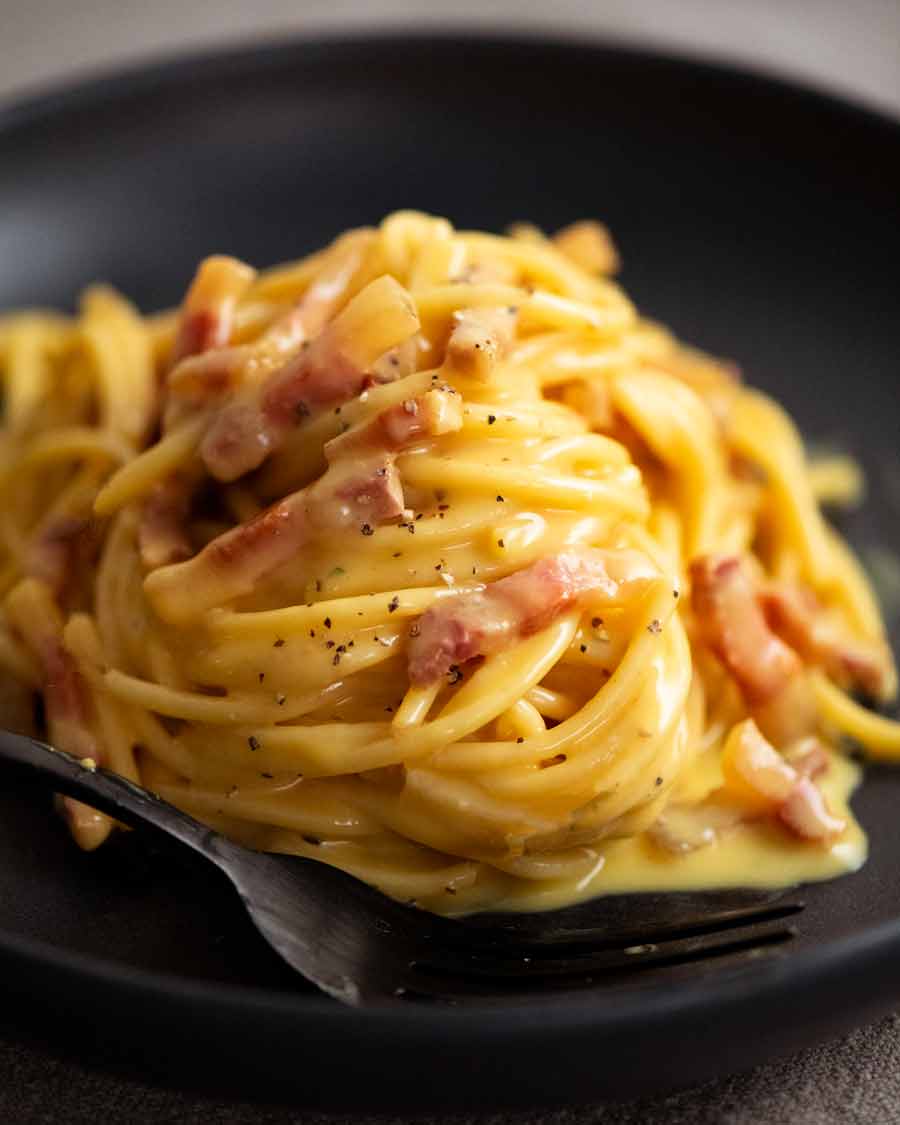
Economical note – Use bacon instead of guanciale and parmesan instead of parmigiano reggiano for a very respectable version of carbonara that will still make Italians proud. But don’t add cream! 😊
Spaghetti carbonara
Carbonara is a beautiful, classic Italian pasta that’s so creamy, you’d swear there’s a good amount of cream in it. And indeed, there’s plenty of recipes that cheat by adding in cream.
But today, we’re making spaghetti carbonara properly, the authentic, traditional way. No cream. Just egg, cheese and a splash of starchy pasta cooking water.
15 minutes later, THIS is the sight that will be in front of you. And you’ll make 60 million Italians beam with pride!
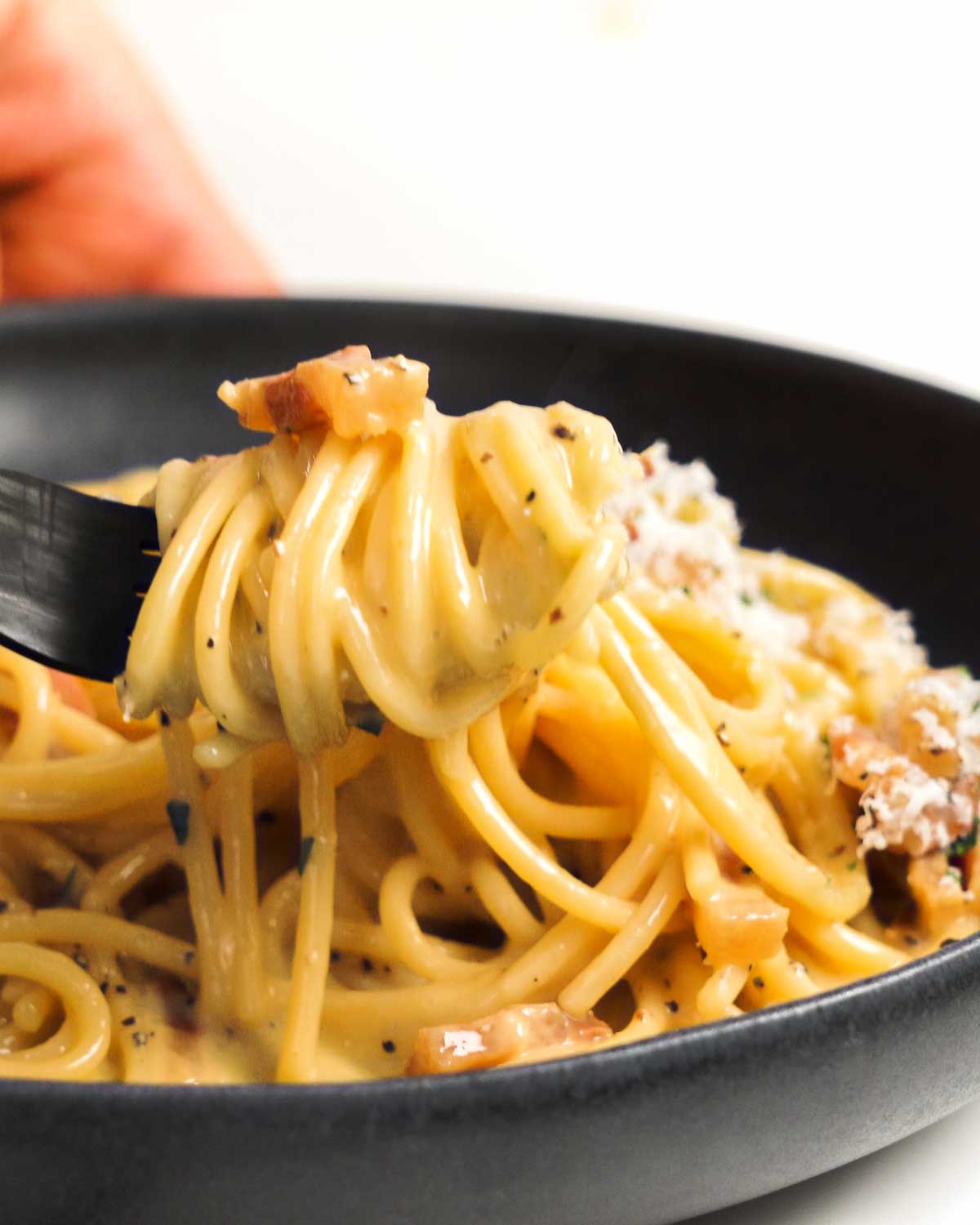
You can imagine eating that mouthful of chewy spaghetti bathed in the creamy sauce, right? Don’t dream about it. Make it a reality!! It’s so quick and easy it will blow your mind!
What happens if I add cream?
Outside of Italy, lots of recipes “cheat” by adding cream into carbonara sauce, for various reasons. Not a bad thing, per se, it’s just that it’s no longer a real carbonara.
But more importantly for me (in addition to, of course, the fact that I’m sharing a recipe with the intention of respecting the origins), cream alters the mouthfeel and flavour. You see, real carbonara is rich and creamy to eat. But you don’t get that slick of dairy fat coating your mouth like you do when eating cream.
Put another way – carbonara is how you get your creamy pasta fix without feeling weighed down like you do when you indulge in pastas doused with heavy cream. Win!
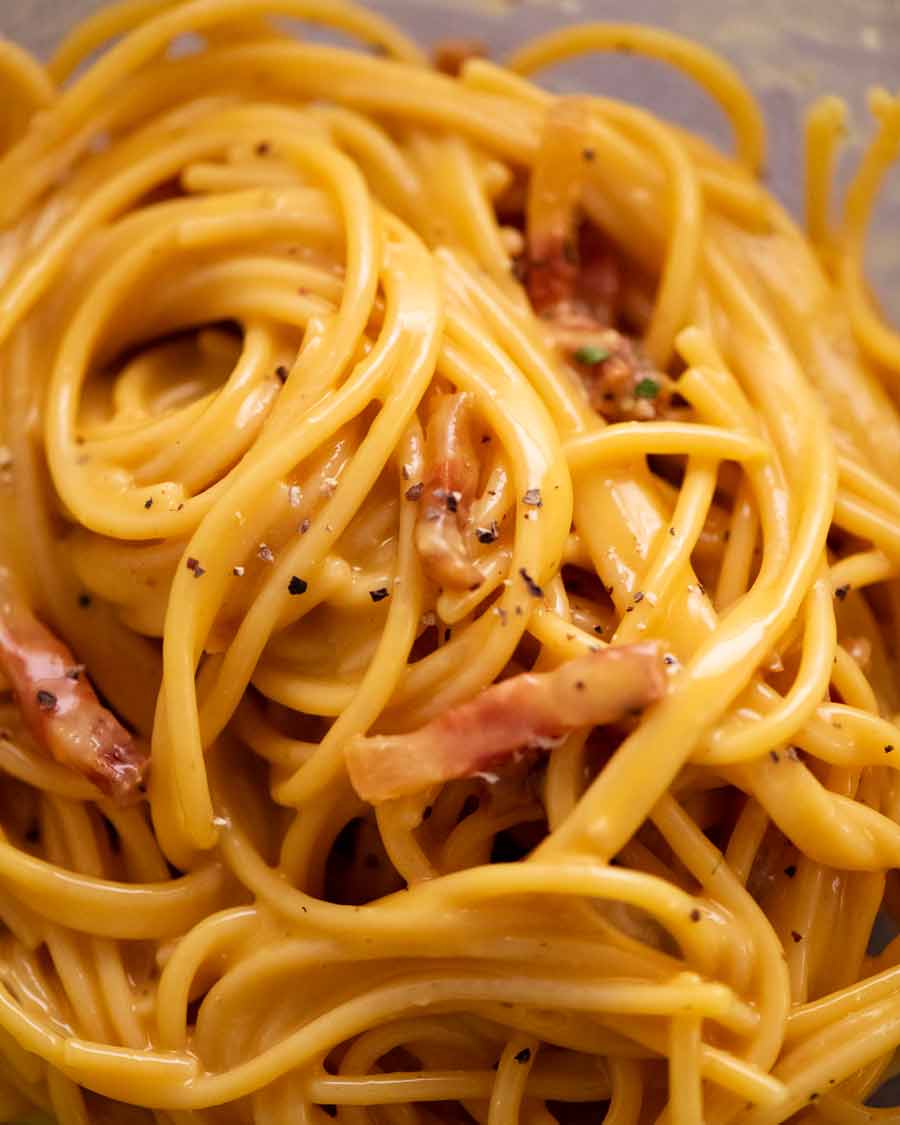
Ingredients in carbonara sauce
Carbonara calls for raw eggs which are stirred vigorously off the stove with hot cooked pasta, guanciale (a cured pork like bacon), parmesan and a splash of pasta cooking water. Watch the magic unfold before your eyes as 4 simple ingredients transforms into a luxurious creamy sauce! NO CREAM allowed! 🙂
Economical note: Substitute guanciale with bacon and use parmesan instead of parmigiana reggiano. You’ll still capture the essence of real carbonara that will make Italians proud!
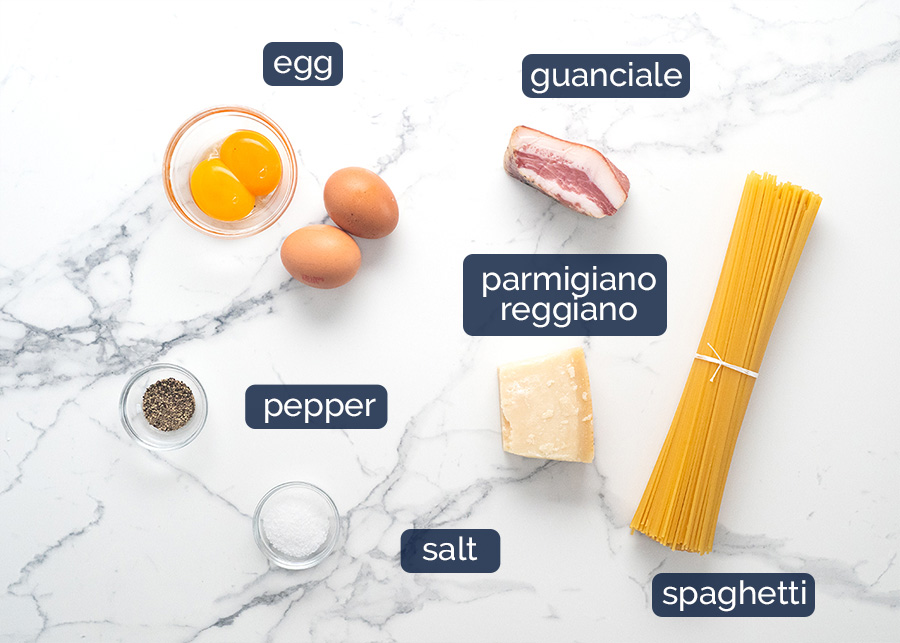
-
Guanciale – This is a key ingredient in carbonara, and is a cured fatty pork that is similar to bacon and pancetta. It adds adds flavour into the dish and the fat makes the sauce creamy when mixed with the egg and starchy pasta cooking water.
Find it at Italian delis, Harris Farms (Syd, QLD), and speciality produce stores. It’s a bit of a speciality product but can be substituted with pancetta or streaky bacon in a pinch! Best to get block form so you can cut it into thick batons. If pre-sliced is all you can get, try to get thick cut.
More information on guanciale below.
-
Parmigiano reggiano – This is basically a premium parmesan that’s been aged so it has more complex flavours. It adds salt into the sauce as well as thickening it. Pecorino romano, which is made from sheep milk, is also commonly used, or a combination of the two. Substitute with parmesan cheese.
Must grate your own! Whatever you use, don’t use store bought pre-grated as it won’t melt properly in the sauce.
-
Egg yolks and whole eggs – The egg combined with the guanciale fat is what makes the stunning creamy carbonara sauce that the world is obsessed with. There’s no need for cream for a creamy sauce! See section above for why.
We use a combination of whole eggs, plus egg yolks for richness. If only yolks are used, the richness is a little too off-the-charts!
Raw egg concerns? These days in developed countries, food safety standards are such that you should not have to be concerned about eating raw eggs sourced from reputable stores. In fact, raw eggs are used more commonly than you probably realise, such as in tiramisu and mayonnaise. So if you’ve ever had any of these at restaurants, you’ve had raw eggs!
However, if you are pregnant or immunity compromised, I would recommend avoiding raw eggs as a precaution. Make fettucine alfredo instead!
-
Spaghetti – While you can use any long pasta, the most common type used is spaghetti.
-
Pepper – For seasoning. Freshly ground black pepper recommended here.
-
No salt in sauce – The pasta cooking water is salted so it flavours the spaghetti as it cooks. And the carbonara sauce gets salt from the guanciale and cheese.
-
Garlic, optional – While not strictly traditional, garlic is a popular addition and it does add extra flavour into it. 🙂
Guanciale for (real) carbonara
Worth hunting down? Yes, if it’s accessible, within your budget and you are keen to experience an authentic carbonara. But bacon or pancetta makes a very respectable substitute!
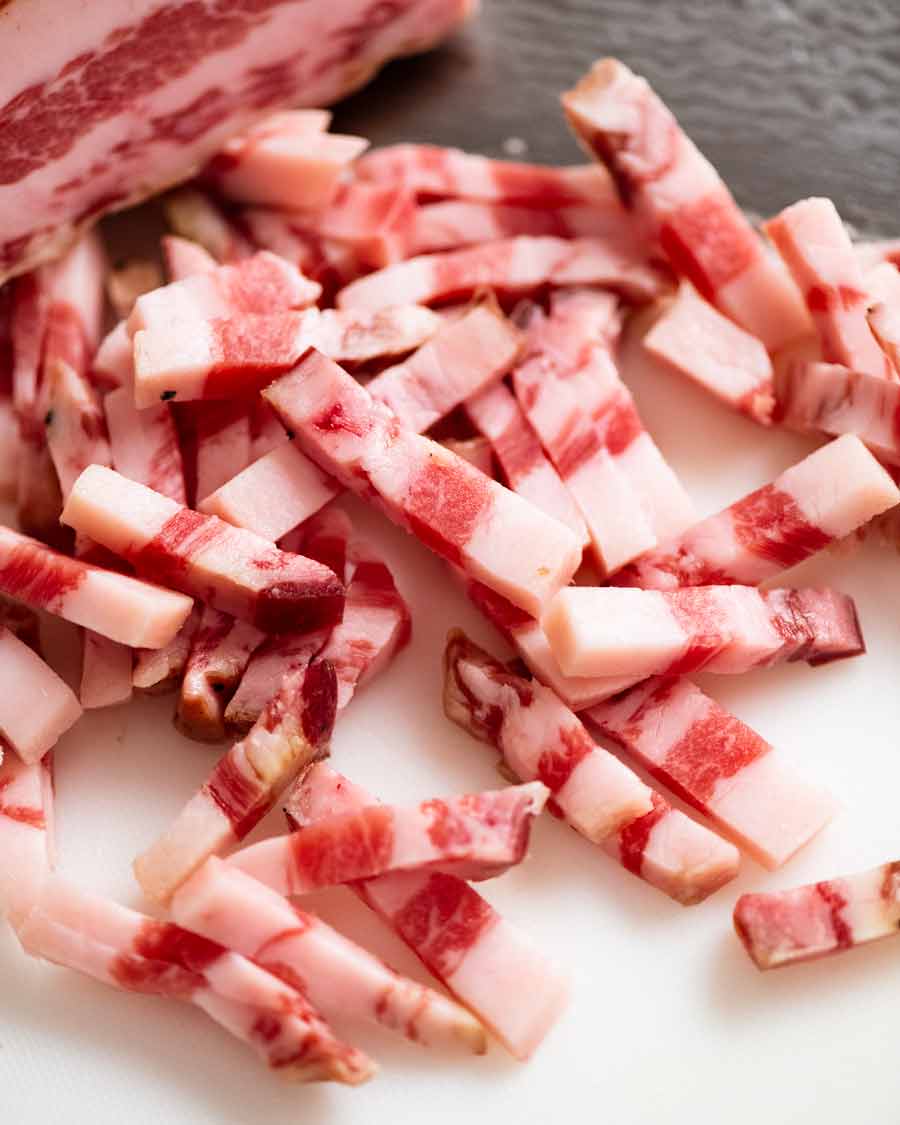
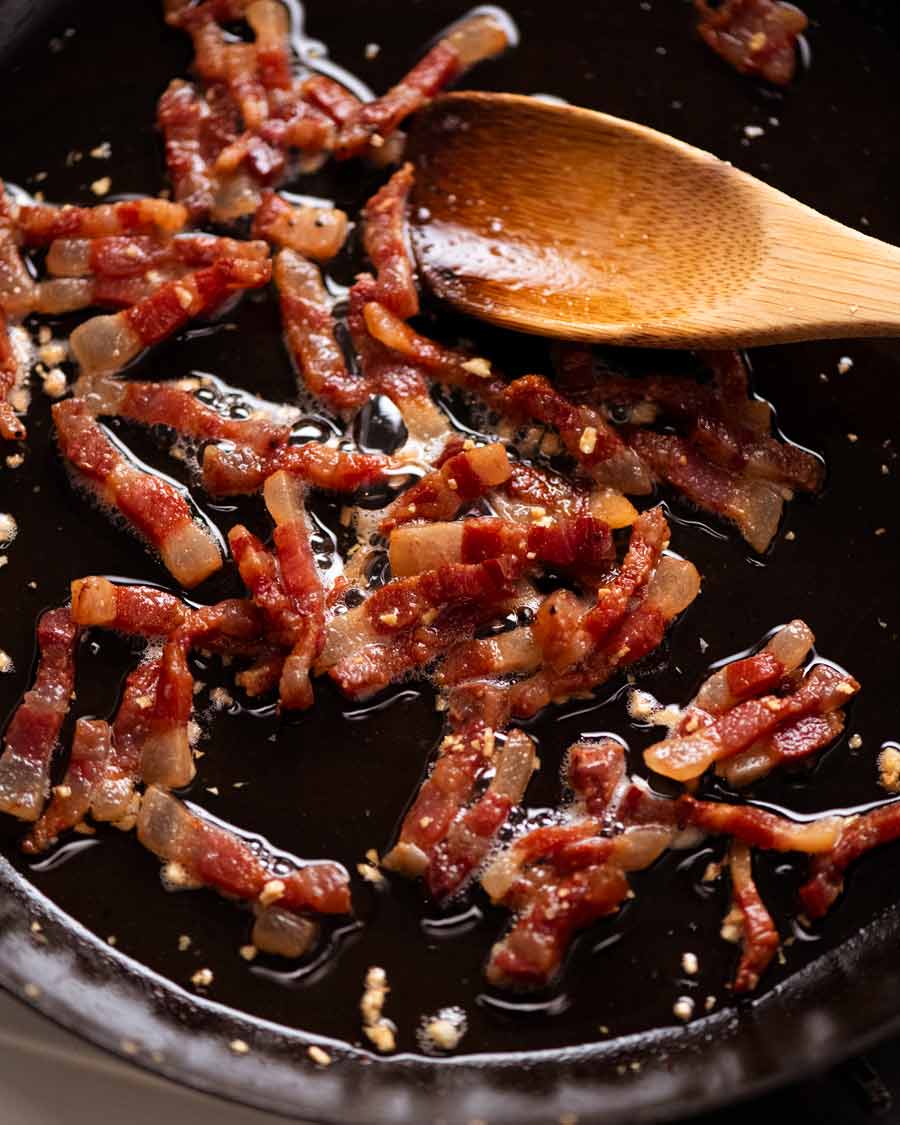
Guanciale is a cured Italian pork that is made from pig jowls or cheek that looks like a block of bacon. It has more intense flavour than everyday bacon because of the pork cut used and it’s aged 3+ months.
It has a high proportion of fat, and that’s exactly as it should be and is needed for carbonara. The fat that melts out of the guanciale when sautéed until golden is a key flavouring for the creamy carbonara sauce.
Equally important is that the fat that melts out of the guanciale is required to thicken the carbonara sauce to make it creamy. Basically, what happens is that when the fat from the guanciale and in the egg yolks is mixed with starchy pasta cooking water, it thickens. This is what makes the sauce creamy and cling to the pasta strands rather than a watery pool in the base of your bowl. You’ll see in the recipe video below!
If you don’t have enough fat (for example, if you try to make this with lean bacon), your sauce will never thicken.
Substitute guanciale with pancetta or bacon, preferably in block form so you can cut it into batons. Biting into the golden brown chunks of guanciale is a highlight of this dish!! Whichever you use, it’s essential to ensure there’s plenty of streaks of fat.
Pre-sliced bacon? It will work but because the slices are thinner than the ideal baton size, you will end up with a lot more bacon bits throughout your dish than pictured in this post. Perhaps not considered a negative, by some! 🙂
How to make (real) carbonara
Sauté guanciale until golden. Mix hot cooked pasta vigorously with the guanciale, egg, cheese and a splash of pasta cooking water and watch as it transforms into a luxurious, creamy sauce.
HOT TIP: Use the handle of a wooden spoon to mix. Fast and effective!
-
Batons – Cut the guanciale into thick batons. Biting through the golden brown crust into meaty bits of salty guanciale is part of the awesomeness that is carbonara!

-
Finely grate the parmigiana reggiano or pecorino. I use a microplane – one of can’t-live-without kitchenware items!

-
Sauce – Whisk together the egg, cheese and pepper in a large bowl. It needs to be a large bowl because the pasta will be stirred into the sauce in the bowl, off the stove, to avoid scrambling the eggs.

-
Cook pasta – Bring 4 litres (4 quarts) of water to the boil with 1 tablespoon of salt. Cook the pasta per packet directions. It should be firm, not soft, but fully cooked through.
-
Reserve pasta cooking water – Just before draining, scoop out one cup of pasta cooking water. Then drain the pasta in a colander.

-
Cook guanciale until golden while the pasta is cooking. You don’t need any oil, the guanciale will fry in its own fat.
-
Toss pasta in guanciale – Tumble the hot pasta into the pan with the guanciale then toss so the pasta gets coated in the guanciale fat.

-
Transfer into sauce bowl – Tip the hot pasta into the bowl with the egg and use a rubber spatula to scrape out every drop of the guanciale fat into the bowl. That stuff is gold! 🙂
-
Add 1/2 cup pasta cooking water into the bowl.

-
Mix vigorously with the handle of a wooden spoon, spinning the pasta around, for around 30 seconds to 1 minute. Watch as the watery pale yellow liquid magically transforms into a creamy sauce.
You know it’s ready when the sauce is no longer watery and pooled in the bottom of the bowl. Instead, it will be thickened, creamy, and clinging to the pasta!

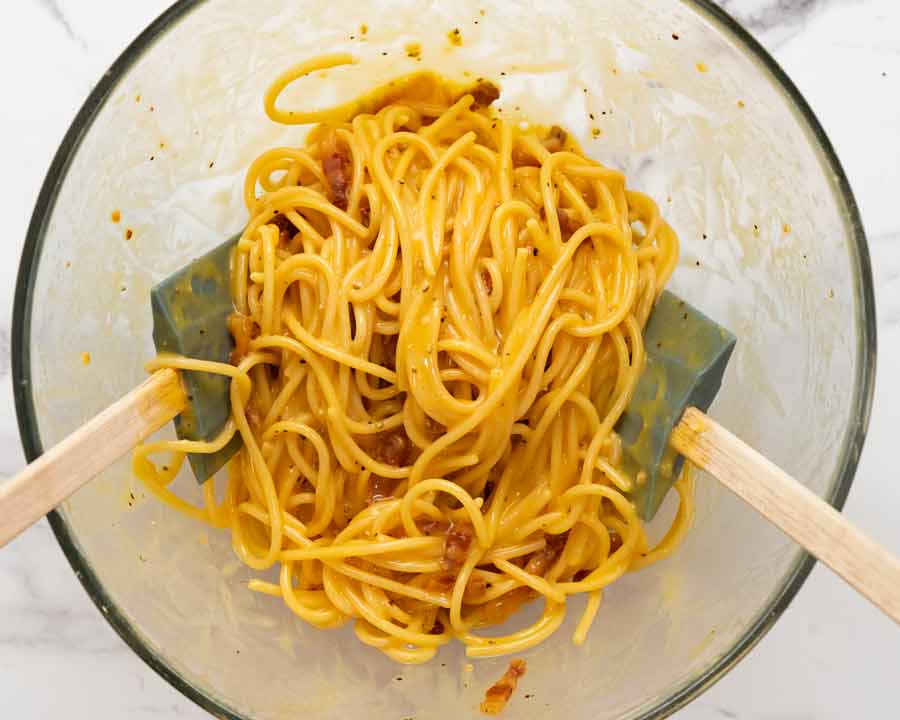
-
Serve immediately in warm bowls. Pasta waits for no one!
Warm bowls? Yes. I don’t usually warm bowls for serving food, but for pasta, I almost always do. This is because pasta is at its best when it’s freshly made with the sauce is slick and the pasta is juicy. As it cools, the sauce thickens and the pasta gets stodgy. A warm bowl prolongs the life of pasta. I just warm bowls by placing a stack in the microwave for 1 minute. Else, run it under hot water or put in a low oven.
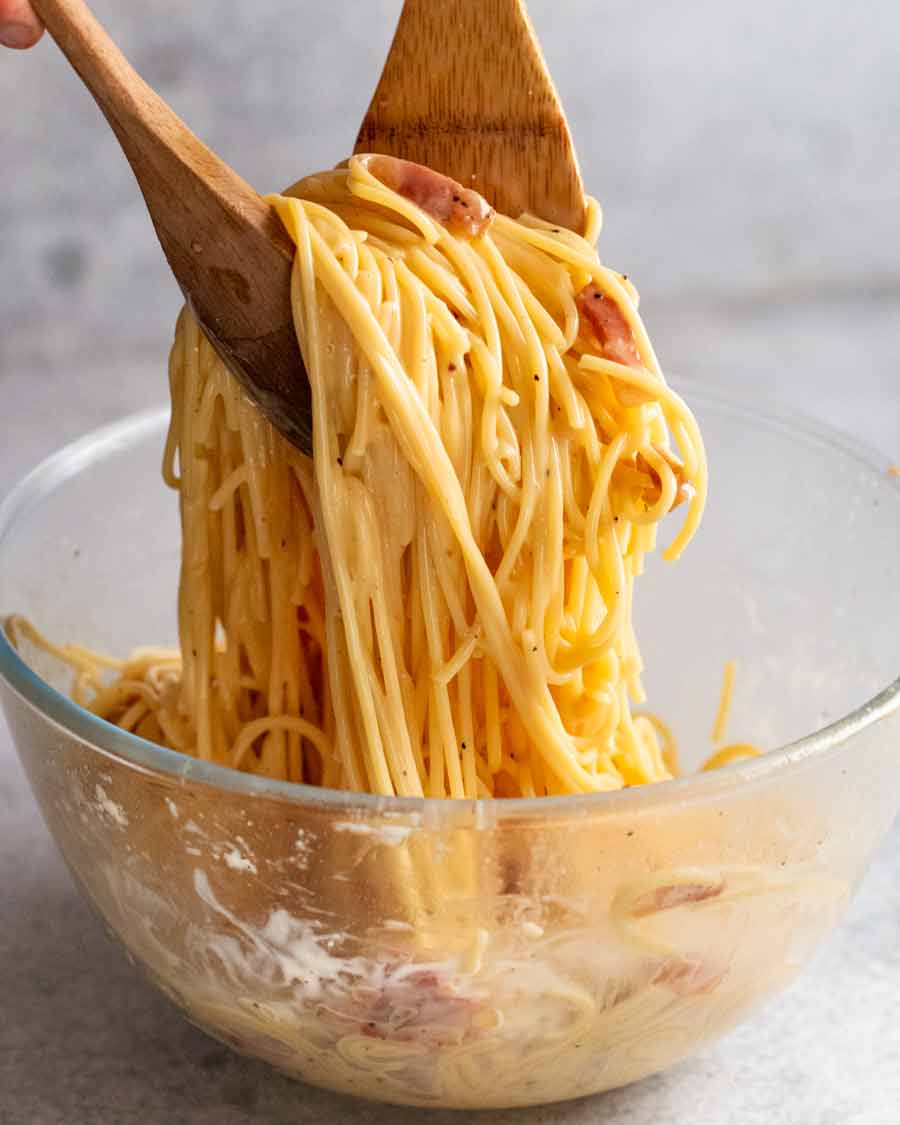
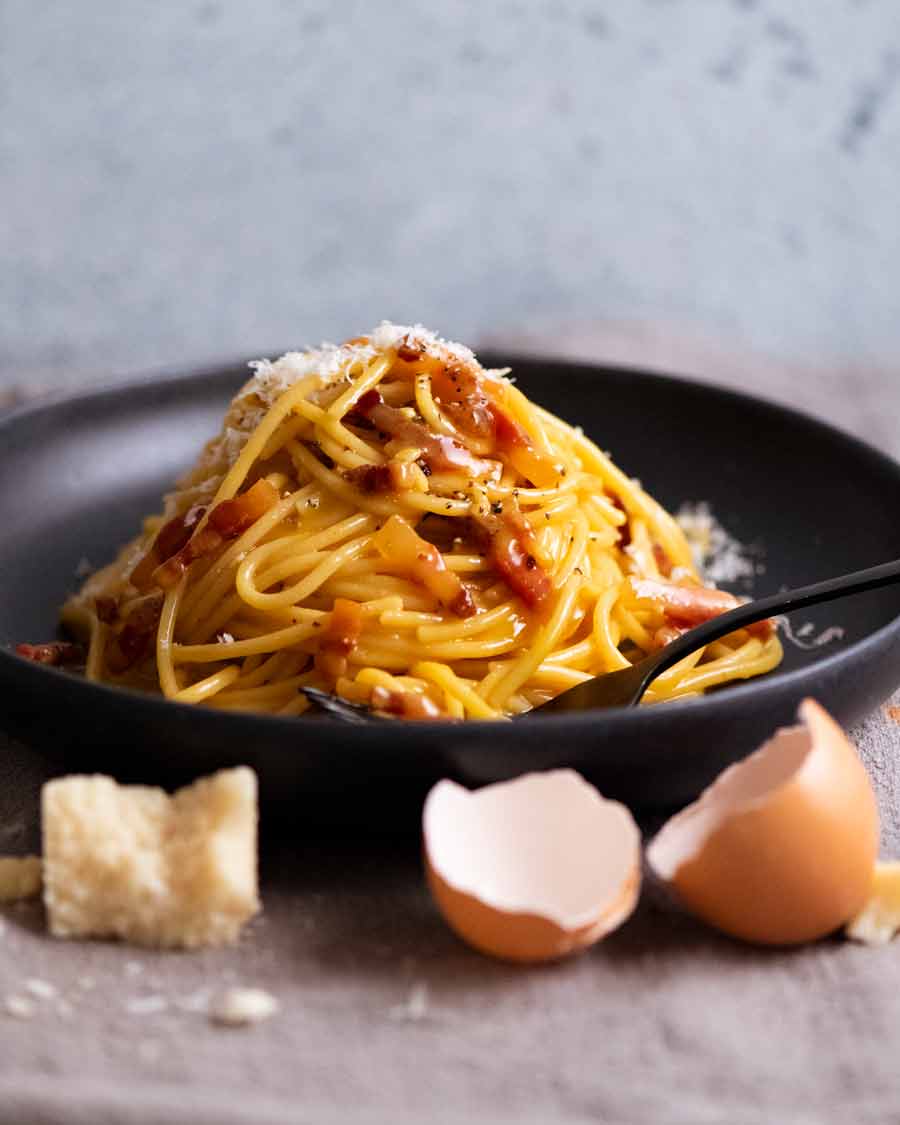
And there you have it. One of the most luxurious pasta dishes in the world. Did you know it was this quick and easy to make? Such is the beauty of Italian food. The simplicity, letting produce take centre stage with a few little tricks to make magnificent good with so few ingredients.
5 ingredients.
15 minutes.
It’s an absolutely stunner. I really hope you try this one day. – Nagi x
Watch how to make it
Hungry for more? Subscribe to my newsletter and follow along on Facebook, Pinterest and Instagram for all of the latest updates.
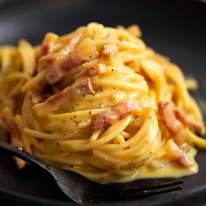
Carbonara (real)
Prep: 5 mins
Cook: 15 mins
Mains
Italian
Servings4
Tap or hover to scale
Instructions
-
Guanciale – Cut into 0.5cm / 1/5″ thick slices then into batons.
-
Carbonara sauce – Place eggs and yolks in a large bowl. Whisk to combine. Then stir in the parmesan and pepper.
-
Cook pasta – Bring 4 litres (4 quarts) of water to the boil with the salt. Add pasta and cook per the packet directions.
-
Reserve pasta water – Just before draining, scoop out 1 cup of pasta cooking water, then drain the pasta.
-
Cook guanciale – While the pasta is cooking, place guanciale in a non stick pan over medium high heat. Cook for 4 to 5 minutes until golden. No oil needed – as the guanciale heats up, the fat will melt so it fries in its own fat. If using garlic, add it in the last minute.
-
Pasta in pan – Tip the hot pasta into the pan and toss to coat in guanciale fat.
-
Mix pasta in sauce – Transfer the pasta and any residual fat in the pan into the bowl with the egg. Add 1/2 cup (125 ml) pasta cooking water. Stir vigorously using the handle of a wooden spoon for 1 minute and watch as the sauce transforms from watery to creamy and clings to the pasta strands!
-
Serve – Transfer into warm bowls. Serve immediately, garnished with a little extra parmigiana reggiano if desired, and a pinch of black pepper and finely chopped parsley.
Recipe Notes:
1. Guanciale is the cured pork traditionally used in carbonara. Sold in block form that you cut yourself, it can be found in Italian/speciality delis, Harris Farms (Syd, Brisbane) and some butchers. It’s very fatty and has a stronger flavour than pancetta and bacon. Substitute with block bacon or pancetta (so you can cut batons), or thick pre-sliced bacon. Must use streaky as sauce needs fat to thicken (read in post for why).
2. Eggs – Use large eggs (cartons labelled as such) which are 55-60g / 2oz each. See here for easy ways to use/store leftover egg whites!
3. Parmigiano reggiano is a premium aged type of parmesan. Pecorino is also commonly used. Sub parmesan. Do not use store bough pre-grated as it will not melt properly. Must finely shred it yourself!
100g/3.5oz is one tightly packed cup ie shred, put in a cup and pack it down tightly.
4. Garlic not traditional but it adds extra flavour and I can’t resist. Sorry Italy! 🙂
5. Leftovers will keep for 3 days but pasta really is always best eaten freshly made, in particular for carbonara!
Life of Dozer
Recently discovered iPhone photo Memories on my phone. Here’s the one that came up today!

